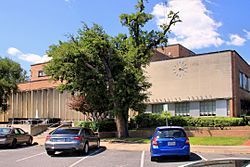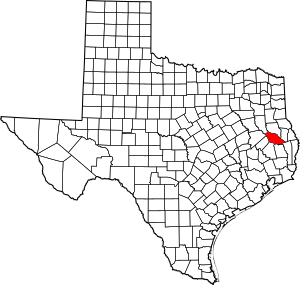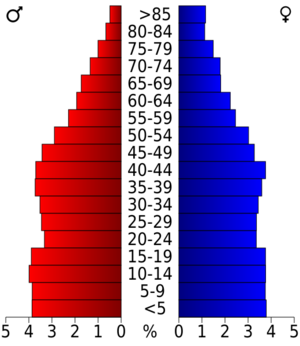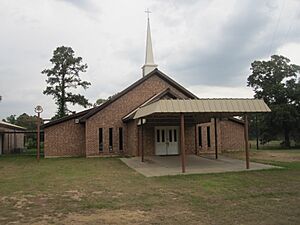Angelina County, Texas facts for kids
Quick facts for kids
Angelina County
|
|
|---|---|

The Angelina County Courthouse in Lufkin
|
|

Location within the U.S. state of Texas
|
|
 Texas's location within the U.S. |
|
| Country | |
| State | |
| Founded | 1846 |
| Named for | A Hasinai woman who assisted early Spanish missionaries and was called Angelina by them |
| Seat | Lufkin |
| Largest city | Lufkin |
| Area | |
| • Total | 865 sq mi (2,240 km2) |
| • Land | 798 sq mi (2,070 km2) |
| • Water | 67 sq mi (170 km2) 7.7% |
| Population
(2020)
|
|
| • Total | 86,395 |
| • Density | 99.88/sq mi (38.563/km2) |
| Time zone | UTC−6 (Central) |
| • Summer (DST) | UTC−5 (CDT) |
| Congressional district | 17th |
Angelina County (/ˌændʒəˈliːnə/ AN-jə-LEE-nə) is a county located in the U.S. state of Texas. It is found in East Texas. The main city and county seat is Lufkin.
In 2020, about 86,395 people lived here. The Lufkin area, including all of Angelina County, is considered a "Micropolitan Statistical Area." This means it's a smaller city area with strong ties to its surrounding county.
Angelina County was created in 1846 from Nacogdoches County. It is named after a Hasinai Native American woman. Early Spanish missionaries called her Angelina because she helped them.
Contents
History of Angelina County
The first European settlers in Angelina County were mostly from Scotch-Irish families. They came from places like Georgia, Alabama, and Mississippi. These pioneers wanted to build homes in the Piney Woods and along the rivers. They farmed a little and raised cattle. They also fished in the Neches and Angelina rivers and hunted for food.
When Texas became independent, not many people lived in Angelina County. The county was officially formed on April 22, 1846. George W. Collins is thought to be the first person to settle there permanently after it became a county.
The population grew quickly because of good farming land and rivers that allowed steamboats to travel. By 1850, there were 1,165 people living in the county. Some of these people were enslaved.
The county seat, which is the main government town, changed a few times. It started in Marion, then moved to Jonesville in 1854, then to Homer in 1858. Finally, in 1892, Lufkin became the county seat. Lufkin was chosen because a railway line, the Houston, East and West Texas Railway, was built through it in 1882.
Many settlers in Angelina County came from the southern United States. Some of them owned large farms called plantations, where enslaved people worked. However, many farmers in Angelina County were not wealthy and did not own enslaved people. In 1847, there were 154 enslaved people out of a total population of 834. By 1859, this number had grown to 427. Farming land in the county increased a lot between 1850 and 1860.
In 1861, when the American Civil War was about to begin, Angelina County was one of the few counties in East Texas that voted against leaving the United States. This was different from its neighbor, Tyler County, which strongly supported leaving. Two groups of men from Angelina County joined the Civil War, but they did not see much fighting. Only 19 men from Angelina County died in the war.
Geography of Angelina County
Angelina County covers a total area of about 865 square miles. Most of this area, about 798 square miles, is land. The remaining 67 square miles, or 7.7%, is water.
Neighboring Counties
- Nacogdoches County (north)
- San Augustine County (northeast)
- Jasper County (southeast)
- Tyler County (south)
- Polk County (southwest)
- Trinity County (west)
- Houston County (west)
- Cherokee County (northwest)
Protected Areas
Part of the Angelina National Forest is located within Angelina County. This is a large area of protected forest land.
People of Angelina County
| Historical population | |||
|---|---|---|---|
| Census | Pop. | %± | |
| 1850 | 1,165 | — | |
| 1860 | 4,271 | 266.6% | |
| 1870 | 3,985 | −6.7% | |
| 1880 | 5,239 | 31.5% | |
| 1890 | 6,306 | 20.4% | |
| 1900 | 13,481 | 113.8% | |
| 1910 | 17,705 | 31.3% | |
| 1920 | 22,287 | 25.9% | |
| 1930 | 27,803 | 24.7% | |
| 1940 | 32,201 | 15.8% | |
| 1950 | 36,032 | 11.9% | |
| 1960 | 39,814 | 10.5% | |
| 1970 | 49,349 | 23.9% | |
| 1980 | 64,172 | 30.0% | |
| 1990 | 69,884 | 8.9% | |
| 2000 | 80,130 | 14.7% | |
| 2010 | 86,771 | 8.3% | |
| 2020 | 86,395 | −0.4% | |
| U.S. decennial census 1850–2010 2010 2020 |
|||
In 2000, there were about 80,130 people living in Angelina County. The population density was about 100 people per square mile. The county is home to people from many different backgrounds.
The average household in Angelina County had about 2.7 people. About 36% of households had children under 18 living with them. Many households were married couples.
The population in the county is spread out across different age groups. About 27.7% of the people were under 18 years old. About 12.6% were 65 years or older. The average age in the county was 34 years old.
Education in Angelina County
Schools for Kids
Several school districts serve the children of Angelina County. Some of these districts are fully within the county, while others cover parts of neighboring counties too.
- Central Independent School District
- Colmesneil Independent School District
- Diboll Independent School District
- Hudson Independent School District
- Huntington Independent School District
- Lufkin Independent School District
- Wells Independent School District
- Zavalla Independent School District
Colleges and Universities
Angelina College is a community college that serves all of Angelina County. It offers classes for students who want to continue their education after high school.
Stephen F. Austin State University is a larger university located nearby in Nacogdoches, which is in Nacogdoches County.
Getting Around Angelina County
Main Roads
 U.S. Highway 59
U.S. Highway 59
 U.S. Highway 69
U.S. Highway 69 State Highway 7
State Highway 7 State Highway 63
State Highway 63 State Highway 94
State Highway 94 State Highway 103
State Highway 103 State Highway 147
State Highway 147 Farm to Market Road 1818
Farm to Market Road 1818
Bus Services
Greyhound Lines has a bus station in Lufkin. It is located at the Kerrville Bus Company station.
Airport
The Angelina County Airport is about seven miles southwest of Lufkin. It serves the county for air travel.
Towns and Places
Cities in Angelina County
Special Community Areas
- Redland is a census-designated place, which means it's a community identified by the census bureau.
Smaller Communities (Unincorporated)
These are smaller towns and areas that are not officially organized as cities.
Ghost Towns
These are places where towns once existed but are now abandoned or have very few residents.
- Alco
- Beulah
- Boynton
- Concord
- Dunagan
- Durant
- Ewing
- Granville
- Manning
- Monterey
- Nancy
- Ora
- Peavy
- Platt
- Rocky Springs
- Shawnee
Gallery
See also
 In Spanish: Condado de Angelina para niños
In Spanish: Condado de Angelina para niños







